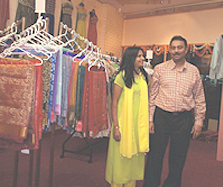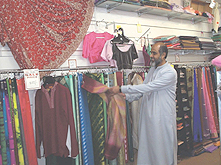Dreams Down UnderUnlike in the West, not too many Aussies go into raptures over Indian clothes, but on a quaint little street in Melbourne—where even the Whites venture—ethnic wear is all the rage
By Indrani Talukdar in Melbourne
|

SET PIECES: The Waghelas of Raj Rani Creations specialise in, what they call, Bollywood creations
|
|
| Heat and dust cake the lengthy boulevard. Over-enthusiastic shopkeepers woo marketers rather aggressively… And no, this is not Chandni Chowk in Delhi. It could be a scene out of Toronto, Chicago or Singapore’s Little India. With the Indian diaspora spreading its wings post-Independence, slices of India appearing in far-flung corners of the globe occasions no surprise. Only Australia, which scrapped its ‘Whites only’ policy only as recently as the 70s, doesn’t seem to have a well-defined south-Asian ethnic spot. Not even the self-consciously multi-cultural Melbourne. Or, so one thought…
It takes about an hour on the Cranbourne Line on a Connex train to get to Dandenong. Once past the obstacle-race-like ticket barriers and the bullying physicality of the Dandenong Railway Station, it takes barely two minutes to get into Foster Street—about a furlong in length. The impeccable neatness and traffic punctuality are the only give-aways. You could well be in Mumbai, judging by the boutiques and restaurants. No blaring music here unlike in Mumbai’s marts or Singapore’s rather sprawling Little India though. And no burnt incense scents emerge from the shops either. Viva Melbourne!
One of the first shops to take the eye is Roshan Fashions run by an architect, Shahid Syed. A Hyderabadi who started the first Indian clothes shop ever in Australia some 17 years ago, has a clientele stretching into the northern states of Queensland and New South Wales. “It was the recession of the 1980s that forced me to go into the clothing business,” he admits quite candidly. The first shop—still in existence—was opened in Sydney. The second outlet sprung up after 15 years, in Melbourne. His first sherwani, he says, was bought by an Australian. Pointing an index finger trembling with emotion, he indicates the framed photograph of an Aussie couple who married in traditional Indian gear while exchanging Christian vows.
While he admits that “not too many Whites buy traditional Indian clothes, you do get to see that odd one out who likes to deck up in an Indian sherwani or ghaghra”. Like the Indian curry the sari too has been adapted to Australian conditions. The custom-made version, needless to say, does not bear the slightest resemblance to the original with straps and belts for pleats and tuck-ins.
Fijians and Malaysians looking for authentic Hyderabadi and Mumbai jewellery need look no further than Roshan’s. Or Raj Rani Creations—a more recent addition to the Foster Street community. The latter’s proprietors—Dinesh and Kaushalya Waghela—specialise in, what they call, “Bollywood creations”. With their wholesalers firmly ensconced in Mumbai, they have to minutely follow filmi fashions back home to get a feel of the contemporary pulse. “We perforce watch Hindi films to know what our clients want,” laughs Dinesh. His wife Kaushalya, also a cancer researcher with Monash University, testifies to the number of times she’s been asked to identify saris resembling those worn by Hema Malini in Baghban and Aishwarya Rai in Devdas. |
|
Like the Indian curry the sari too has been adapted to Australian conditions. The custom-made version does not bear the slightest resemblance to the original |

PIONEER: Shahid Syed from Hyderabad started the first Indian clothes shop in Australia some 17 years ago
|
|
| Shahid too refers to ‘Bollywood parties’—parties with Bollywood themes—becoming increasingly popular in Melbourne. As if to illustrate his point, a Mauritian lady with a heavy French accent walks in and asks for some alterations in her gaudy lehenga fitting. “There is a Bollywood theme party at a friend’s place today,” she remarks, airily omitting details. “We have our own tailors who do the needful,” explains Syed, putting his Nokia handset down, having delivered crisp sartorial instructions in quaint Hyderabadi Hindi.
The Indianisation of the snail-like Foster Street seems to have occurred by accident. Unlike Little India in Singapore there are no loud posters here proclaiming ‘namaste’ in Hindi or inviting the potential tourist into its curried Indian embrace with Punjabi signposts as in Vancouver. Even the uncompromisingly ‘Indian’ India Bazaar does not reek with ethnic scents despite the bloated grocery packaging in crude jute sacks heaped across the shop floor. The signs are all in English.
Sociologists and cultural theorists will find echoes of Altman and Taylor’s 1973 social penetration theory in this odd milieu. The theory which posits four stages of relationship development in a new social backdrop—orientation, exploratory affective exchange, affective exchange, and stable exchange—stops short at the second stage here. The first, i.e. the orientation stage, “is characterised by responses that are stereotypical and reflect superficial aspects of the personalities of the individuals involved in a relationship.”
Homesick Indians in far-off Dandenong will be relieved by the sudden sight of Sohna’s sarson ka saag and Haldiram’s gulab jamuns illustrative of the exploratory exchange stage which “involves interaction at the periphery of the personalities of the partners.” This stage includes relationships that are “friendly and relaxed” but commitments are limited and temporary. Few Aussies visit mini India in this hilly corner although, says its proprietor Hari Singh, “quite a few Aussies come asking to rent DVDs of that pretty girl, what’s her name?, ah yes, Aishwarya
Rai!”
India Bazaar adds yet another ‘first’ to the Foster Street cap. The first of its kind in Australia, it earlier belonged to a Pakistani businessman in 1996. Loath to discuss his turnover, India Bazaar is the best known grocery shop in all of Australia, proclaims its proprietor proudly.
Apart from the odd pizza corner and the aggressively Vietnamese food joint, some 16 Indian outlets flank the diminutive Foster Street like droplets on a misshapen handle. It is also here that you will come across original Bollywood ware, a rarity in Melbourne. Thanks to the fastidious efforts of a Fijian Indian who calls himself Baba, and his music store—Baba Music House. The prices here are steep. A Mughal-e-Azam DVD, for instance, comes for a whopping $28 as opposed to the fakes available elsewhere for $5. Yet the buying crowd never stops milling around the shop. Right upto 8 p.m. Preity Zinta and Saif Ali Khan who were in Melbourne recently would have been proud of Baba had they known. Their comments on anti-piracy aired by the local media have become the theme song of the new generation.
“I never sell fake,” says a beaming Baba, “not even at the cost of my business.” One can almost hear Bollywood murmur in approval.
The ethnic dominance on Foster Street has festered some local sores. Kathryne Turton-Lane, one of the first shop-owners to move into the street some 20 years ago, reflects rather bitterly, “All this is just a fad and will pass away. After all, how many saris can anyone buy in one year?” A passing Gujarati customer, hearing the comment, says, “There is something enduring about Indian fashions. Every sari is an investment—as it never goes out of vogue.”
Amen. |
|
|
|
|
|
|
November 2005
|
|

|
|
|
|